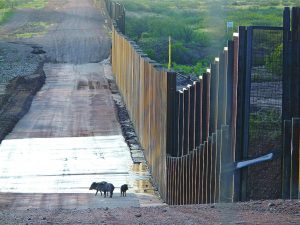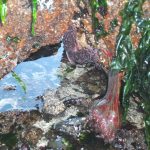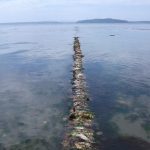A family of javelinas encounters the U.S.-Mexico border wall near the San Pedro River in southeastern Arizona (copyright photo by Matt Clark, Defenders of Wildlife; non-commercial use allowed with credit and copyright).
Since the first barriers were built in 1994, the Mexico-United States has been a controversial political topic. Growing up near Seattle, I had my own opinions about the border wall. But I never saw it. I never had to deal with unwanted stops by the U.S. border patrol. I wasn’t separated from my family by a wall. As far as I was concerned, in my Pacific Northwest life, the wall was completely out of mind It was part of my invisible present. The invisible present is when something is invisible to individual observations, and is usually a slow change that can go unnoticed. It was when I visited the Sonoran Desert in Arizona when I was seventeen as part of a summer camp, that I had to actually think about all the consequences of the wall. I volunteered at a place called Borderlands Restoration, where we helped pot plants that would later be placed near the border wall the help with habitat restoration.
For one of our summer camp activities we had guest speakers from Sierra Club to talk about the border wall . I learned that the wall, even parts that people could get around easily, were a huge barrier for some animals. It blocked migration patterns, caused flooding, and damages wild lands (https://www.sierraclub.org/borderlands). I still have the posters up in my room from the Sierra Club, in both English and Spanish, reminding myself of the the animals wishing to be free of the wall. I was fascinated by all this new information, and embarrassed I hadn’t taken into consideration the environmental aspects of our political borders. How could I, an animal lover and environmentalist, not think about all this?
Desert hares are impacted by the border wall. They might be able to get under some road blockades, but any section of the wall more than a couple feet high is too tall for them to get around. https://pxhere.com/en/photo/744237
I had fallen into an unfortunate social norm. Until I had been made aware of the issue I had the “out of sight, out of mind” mentality without meaning to. I’m not alone in this. People tend not to act on environmental issues, even important ones, unless they see other people working on making changes. Proof of this mindset has been found in a study on hotels trying to be more environmentally friendly. “Using Social Norms to Motivate Environmental Conservation in Hotels”, found that hotel guests were more likely to participate in a towel reusing program if they believed that others were reusing their towels, more so than if they just saw a note asking them to reuse their towels. Admittedly, if I had seen my peers from the PNW acting on environmental justice at the border wall I would be a lot more interested as well.
To protect future harm to the wildlife near the wall, we must make it a social norm to hold politicians accountable for environmental impacts. There is a disconnect between what is known by environmental scientists and the social norms of the United States in 2019. But as always there is still time, as mentioned in Measuring Social Norms, “if social norms are learned, they may be modified over time”(284). We have to start by enlightening those who do not see the effects first hand, because they do not know the consequences of having built a wall, and possibly, a bigger wall in the future. “In such conflict situations… if the student perceived an overlap between his preference and the preference of the authorities, he was quite likely to select the authorities in which both approved.”(290) The government has made it acceptable to build a wall, and to shutdown the government to build a bigger wall, and there is not enough questioning the environmental consequences.
Bibliography
“How Would a Border Wall Affect the Environment?” TIME, 27 Feb. 2017, youtu.be/S3M_XEsr6kA.
Goldstein, Noah J, et al. “Room with a Viewpoint: Using Social Norms to Motivate Environmental Conservation in Hotels.” JSTOR, Journal of Consumer Research, Volume35 Issue3 3 Mar. 2008, academic.oup.com/jcr/article/35/3/472/1856257.
Labovitz, Sanford, and Robert Hagedorn. “Measuring Social Norms.” The Pacific Sociological Review, vol. 16no. 3July 1973, pp. 283–303., doi:10.2307/1388488.







0 Responses to “The Invisible Victims of the Mexico-United States Border”